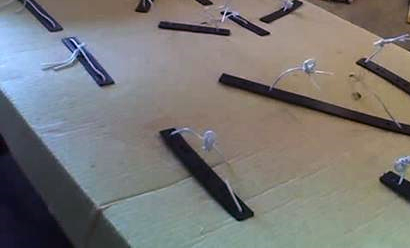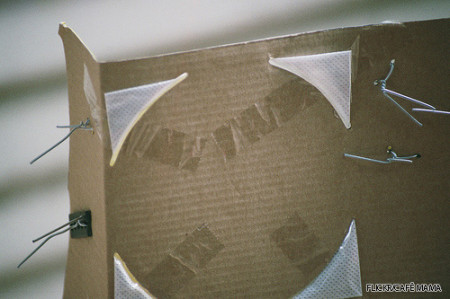Why Toy Packaging Adds to the MSRP

The next time that you open a new toy I want you to take a moment and look at the packaging. Cardboard, plastic blisters, wire or paper ties . . . everything you’re looking at increased what you paid for that toy. Every single bit of packaging — even those annoying rubber straps that threaten to warp your figure if he isn’t released from his presentation prison immediately — adds to the final MSRP of the toy. Why is that? And just why do companies invest so much time and money into packaging?
Because they have to.
I’m Paying for What Now?
Take a look at the below photo. I’m sure many of you have encountered this very scene before when opening a new toy. Every single one of those plastic bits, every twist tie, even that e-flute cardboard backing cost someone money, and the toy manufacturers aren’t so Santa-like in their joyous activities that they won’t pass those costs on to the consumer. No, each of those little bits increases the costs of your toys, and as we see raw material and labor costs around the world continue to climb the cost of encasing action figures and toys in these elaborate webbed prisons skyrockets with it. It’s not just the cost of the toy inside that’s making so many 6-inch scale action figures clock in at $20 or so these days.

And while all of that packaging does add to the costs, the Toy Industry Association tells us that the packaging is there to protect the toys so that the buyer gets exactly what they paid for.
“Tamper-resistant packaging ensures that a product is not lost, broken or damaged during shipping and display, and that small products or those that have multiple components are received in their intended state and are operational and safe upon purchase.”
—TOY INDUSTRY ASSOCIATION (TIA) STATEMENT ON PACKAGING / ENVIRONMENTAL SUSTAINABILITY
I’m not so sure if all of those twist ties and rubberbands really are necessary to the protection of toys in stores. I understand the idea that they want the toys displayed attractively to the customers, but back in my day the toy companies used artwork to excite kids. Hell, how many Masters of the Universe vehicles and accessories did Mattel sell back in the eighties using incredible painted artwork on the boxes?

It’s All About Presentation
Back in the seventies and eighties — you know, the good old days — action figures were often packed loose inside a blister and left to rattle and roll around. It worked just fine and sold millions of action figures, but as the science of merchandising improved the marketers at toy companies figured out how to dramatically make the toys look more appealing: Make sure the figure always stares straight ahead on the package!
And showing isn’t enough for toys these days. Interactive packaging — you know, the “try me!” levers and buttons and gizmos — requires that a toy be secure, accessible, and attractive. All of which adds layers of twist ties, cardboard, and wires to an already-overwhelmed package. The Mental Floss site knows all of this and even posted an article about toy packaging which many of you will want to read:
“. . . manufacturers want to give kids, and adults, as much of the experience of the toy as they can right there on the store shelf. The consumer should see the whole toy, and if it lights up or makes noise, they should be able to test it right there in its box. ”
Is There a Solution?
Maybe, but the only answer I can think of to reduce the amount of packaging used for toys may require an even bigger investment than just sticking with the twist ties and cardboard bits and chunks of plastic.
- Advertise! Specifically, television advertising and online video advertising. (Maybe even more online advertising than television advertising these days.) The death of Saturday morning cartoons and the loss of after school blocks of animated features has left toy companies with fewer places to run commercials, but nothing beats an awesome ad for getting kids excited about a toy.
Commercials are expensive — both from a creation standpoint and actually airing them on television — so this solution (as I said) may be too pricey to be realistic. And I speak from experience when I say that advertising in national magazines can be scary. Comics these days are also expensive when it comes to buying advertising.
Direct Sales?
Could online sales directly to the consumer fix the packaging problems? Small toy companies — like Onell Design — use minimal packaging so it could work. But then we get the Matty Collector site and find some of the worst levels of packaging waste known to man. A box around the figure that is then placed inside another box? Pure waste! And we won’t even get into those stretchy bands Mattel loves to wrap around their action figures.
No Answer
I don’t have a solution. But until the toy manufacturers find a better way to protect and display their toys negative articles about excessive toy packaging will continue to appear online. Slate.com’s article on packaging in general claims things are getting better, so maybe we’re only a year or two from eco-friendly, easy-to-handle toy packaging.
Until that day happens, though, we can all expect to keep paying for the wrappings that wind up in the trash.
Hopefully toy prices will drop a little once manufacturers find a way to eliminate some of the twist ties and excess cardboard. Probably not, though, since other costs are likely to keep rising. Yeah, I’m all full of cheer today.
Interesting article… I think. While in most cases collectors see packaging as merely what comes between them and their latest treasure, but I can fully appreciate it for all the things you have lined out and more. I may be pining for nostalgia here, but in many ways the packaging is as much a part of the experiencing of buying and owning a toy. We want pretty box art and cards with bios and details about the figure. It’s eye catching for little kidlets and lets soccer moms know exactly what they’re buying. In days of past it let us know what else was out there to buy (I still get a semi just looking at the back of a vintage TMNT package).
From a more practical standpoint I want nice sturdy packaging to ensure that the contents inside make it from China, Malaysia, or wherever they’re shipping from to my Toys R Us where they have the potential to be tossed around, dropped, manhandled by kids before acutally getting MY hands on it. Sure some of it may seem excessive but especially for larger figures that can’t be simply shipped in a bubble I appreciate it in the long run.